Energy Efficient Multipath Routing Algorithm for Wireless Multimedia Sensor Network
Abstract
1. Introduction
- We propose a novel algorithm for dividing the network into clusters each with a cluster head (CH) to save more energy and to improve network lifetime.
- We proposed energy efficient multipath algorithm with dynamic clustering using Genetic Algorithm (GA) based meta-heuristic optimization technique.
- We performed an extensive performance analysis of the proposed energy efficient multipath algorithm and compared it with several states of the art routing algorithms for WMSN
2. Related Work
3. System Model
3.1. Network Model
3.2. Energy Model
3.3. Problem Overview
4. Energy Efficient GA-Based Multipath Routing
4.1. Cluster and Cluster Head Formation
| Algorithm 1: Cluster Formation |
| 1: Assign delay time for every node |
| 2: Event radius is R |
| 3: Calculate based on |
| 4: WHILE ( 0) DO |
| 5: IF ) THEN |
| 6: IF(() && ( |
| 7: // number of nodes in the cluster |
| 8: END |
| 9: END |
| 10: END |
| Algorithm 2: Selection of Cluster Head |
| BEGIN |
| 1: INPUT: m nodes in a cluster |
| 2: FOR i1: m |
| 3: calculates its cost as |
| 4: END-FOR |
| 5: Assign delay time for every non-CH node in the cluster |
| 6: WHILE ( |
| 7: wait moreover, all nodes in the cluster receive CH request from other members; |
| 8: Assign the node with higher cost value to be CH |
| 9: END-WHILE |
| 10: CH sends an advertisement message to other nodes in the cluster; |
| 11: Connect CH with other remaining non-CH members for data communication |
| 12: END |
4.2. Multipath Formation Using Genetic Algorithm
4.2.1. Encoding of Chromosome
4.2.2. Fitness Function
4.2.3. Crossover
4.2.4. Mutation
| Algorithm 3: Genetic Algorithm |
| BEGIN |
| 1: Initialize population with equal to cluster size |
| 2: Determine the fitness value for each sensor node |
| 3: REPEAT |
| 4: Select parent chromosomes from the population |
| 5: Perform Crossover operation to produce a new child |
| 6: Perform mutation |
| 7: Compute the fitness of each mutated individual |
| 8: IF (Child has higher fitness value) |
| 9: Substitute the parents by the new offspring |
| 10: END |
| 11: END |
| END |
5. Performance Analysis
5.1. Experimental Setup
- Average Residual Energy: This parameter provided the mean remaining node’s energy per round, where is the number of nodes in the network:
- Energy Consumption: This parameter provided node’s energy dissipation in the event region per round, and m is the number of nodes in the cluster:
- Standard deviation (SD): This parameter showed the variation between the individual node’s energy consumption versus the mean energy consumption of the nodes in the network per round. Small SD values signify better load distribution in the network.
- Lifetime of Network: This parameter provided the duration for which the network would continue to serve the purpose it wasmadefor, without failing. There are various definitions given for network lifetime by researchers [50,51]. Some researchers define network lifetime as the duration until a certain percentage of nodes die or remain alive: first node die (FND), half node die (HND), and last node die (LND). Similarly, we defined network lifetime as the time the network took for the first node to die (FND).
5.2. Discussion of Results
5.2.1. Homogenous Network
5.2.2. Heterogeneous Network
6. Conclusions
Author Contributions
Acknowledgments
Conflicts of Interest
References
- Buratti, C.; Conti, A.; Dardari, D.; Verdone, R. An overview of wireless sensor networks technology and evolution. Sensors 2009, 9, 6869–6896. [Google Scholar] [CrossRef] [PubMed]
- Bouchemel, A.; Abed, D.; Moussaoui, A. Enhancement of Compressed Image Transmission in WMSNs Using Modified μ-Nonlinear Transformation. IEEE Commun. Lett. 2018, 22, 934–937. [Google Scholar] [CrossRef]
- Feng, W.; Hu, C.; Wang, Y.; Zhang, J.; Yan, H. A Novel Hierarchical Coding Progressive Transmission Method for WMSN Wildlife Images. Sensors 2019, 19, 946. [Google Scholar] [CrossRef] [PubMed]
- Almalkawi, I.T.; Guerrero Zapata, M.; Al-Karaki, J.N.; Morillo-Pozo, J. Wireless multimedia sensor networks: Current trends and future directions. Sensors 2010, 10, 6662–6717. [Google Scholar] [CrossRef] [PubMed]
- Mahlein, A.K. Plant disease detection by imaging sensors–parallels and specific demands for precision agriculture and plant phenotyping. Plant Dis. 2016, 100, 241–251. [Google Scholar] [CrossRef] [PubMed]
- Shi, H.; Hou, K.M.; Diao, X.; Xing, L.; Li, J.J.; De Vaulx, C. A wireless multimedia sensor network platform for environmental event detection dedicated to precision agriculture. arXiv 2018, arXiv:1806.03237. [Google Scholar]
- Dominguez-Morales, J.P.; Rios-Navarro, A.; Dominguez-Morales, M.; Tapiador-Morales, R.; Gutierrez-Galan, D.; Cascado-Caballero, D. Wireless sensor network for wildlife tracking and behavior classification of animals in Doñana. IEEE Commun. Lett. 2016, 20, 2534–2537. [Google Scholar] [CrossRef]
- Wang, H.; Fapojuwo, A.O.; Davies, R.J. A wireless sensor network for feedlot animal health monitoring. IEEE Sens. J. 2016, 16, 6433–6446. [Google Scholar] [CrossRef]
- Usman, M.; Jan, M.A.; He, X.; Chen, J. A Mobile Multimedia Data Collection Scheme for Secured Wireless Multimedia Sensor Networks. IEEE Trans. Netw. Sci. Eng. 2018, 1. [Google Scholar] [CrossRef]
- Koyuncu, M.; Yazici, A.; Civelek, M.; Cosar, A.; Sert, M. Visual and Auditory Data Fusion for Energy-Efficient and Improved Object Recognition in Wireless Multimedia Sensor Networks. IEEE Sens. J. 2019, 19, 1839–1849. [Google Scholar] [CrossRef]
- Shen, H.; Bai, G. Routing in wireless multimedia sensor networks: A survey and challenges ahead. J. Netw. Comput. Appl. 2016, 71, 30–49. [Google Scholar] [CrossRef]
- Kotecha, K.; Popat, S. Multi-objective genetic algorithm based adaptive QoS routing in MANET. In Proceedings of the 2017 IEEE Congress on Evolutionary Computation, Singapore, 25–28 September 2007; pp. 1423–1428. [Google Scholar]
- Son, D.; Krishnamachari, B.; Heidemann, J. Experimental Study of Concurrent Transmission in Wireless Sensor Networks. In Proceedings of the 4th International Conference on Embedded Networked Sensor Systems (SenSys ’06), Boulder, CO, USA, 31 October–3 November 2006; pp. 237–250. [Google Scholar]
- Woo, A.; Tong, T.; Culler, D. Taming the Underlying Challenges of Reliable Multihop Routing in Sensor Networks. In Proceedings of the 1st International Conference on Embedded Networked Sensor Systems, Los Angeles, CA, USA, 5–7 November 2003. [Google Scholar]
- Abbas, N.; Yu, F.; Fan, Y. Intelligent Video Surveillance Platform for Wireless Multimedia Sensor Networks. Appl. Sci. 2018, 8, 348. [Google Scholar] [CrossRef]
- Ghanavati, S.; Abawajy, J.; Izadi, D. A fuzzy technique to control congestion in WSN. In Proceedings of the 2013 International Joint Conference on Neural Networks (IJCNN), Dallas, TX, USA, 4–9 August 2013; pp. 1–5. [Google Scholar]
- Li, S.; Kim, J.G.; Han, D.H.; Lee, K.S. A Survey of Energy-Efficient Communication Protocols with QoS Guarantees in Wireless Multimedia Sensor Networks. Sensors 2019, 19, 199. [Google Scholar] [CrossRef] [PubMed]
- Mehta, K.; Pal, R. Energy Efficient Routing Protocols for Wireless Sensor Networks: A Survey. Int. J. Comput. Appl. Technol. 2017, 975, 8887. [Google Scholar] [CrossRef]
- Habib, M.A.; Moh, S. Robust Evolutionary-Game-Based Routing for Wireless Multimedia Sensor Networks. Sensors 2019, 19, 3544. [Google Scholar] [CrossRef] [PubMed]
- Ghrab, D.; Jemili, I.; Belghith, A.; Mosbah, M. Correlation-Free MultiPath Routing for Multimedia Traffic in Wireless Sensor Networks. In International Conference on Ad-Hoc Networks and Wireless; Puliafito, A., Bruneo, D., Distefano, S., Longo, F., Eds.; Springer: Cham, Switzerland, 2017; Volume 10517. [Google Scholar]
- Wang, J.; Zhang, Y.; Wang, J.; Ma, Y.; Chen, M. PWDGR: pair-wise directional geographical routing based on wireless sensor network. IEEE Internet Things J. 2014, 2, 14–22. [Google Scholar] [CrossRef]
- Cheng, L.; Niu, J.; Di Francesco, M.; Das, S.K.; Luo, C.; Gu, Y. Seamless streaming data delivery in cluster-based wireless sensor networks with mobile elements. IEEE Syst. J. 2015, 10, 805–816. [Google Scholar] [CrossRef]
- Intanagonwiwat, C.; Govindan, R.; Estrin, D.; Heidemann, J.; Silva, F. Directed diffusion for wireless sensor networking. IEEE/ACM Trans. Networking 2003, 11, 2–16. [Google Scholar] [CrossRef]
- Shin, K.-Y.; Song, J.; Kim, J.; Yu, M.; Mah, P.S. REAR: reliable energy aware routing protocol for wireless sensor networks. In Proceedings of the 9th international conference on advanced communication technology, Kobe, Japan, 12–14 February 2007. [Google Scholar]
- Araki, D.; Yoshihiro, Y. A Distance-Vector-Based Multi-Path Routing Scheme for Static-Node-Assisted Vehicular Networks. Sensors 2019, 19, 2688. [Google Scholar] [CrossRef]
- Ben-Othman, J.; Yahya, B. Energy efficient and QoS based routing protocol for wireless sensor networks. J. Parallel Distrib. Comput. 2010, 70, 849–857. [Google Scholar] [CrossRef]
- Amgoth, T.; Jana, P.K. Energy and coverage-aware routing algorithm for wireless sensor networks. Wirel. Pers. Commun. 2015, 81, 531–545. [Google Scholar] [CrossRef]
- Huang, G.M.; Tao, W.J.; Liu, P.S.; Liu, S.Y. Multipath ring routing in wireless sensor networks. In Applied Mechanics and Materials; Trans Tech Publications: Zurich, Switzerland, 2013; Volume 347. [Google Scholar]
- Felemban, E.; Lee, C.G.; Ekici, E. MMSPEED: Multipath Multi-SPEED protocol for QoS guarantee of reliability and. Timeliness in wireless sensor networks. IEEE Trans. Mob. Comput. 2006, 5, 738–754. [Google Scholar] [CrossRef]
- Yang, J.; Xu, M.; Zhao, W.; Xu, B. A multipath routing protocol based on clustering and antcolony optimization for wireless sensor networks. Sensors 2010, 10, 4521–4540. [Google Scholar] [CrossRef] [PubMed]
- Gupta, S.K.; Kuila, P.; Jana, P.K. GAR: An energy efficient GA-based routing for wireless sensor networks. In International Conference on Distributed Computing and Internet Technology; Springer: Berlin/Heidelberg, Germany, 2013. [Google Scholar]
- Kuila, P.; Gupta, S.K.; Jana, P.K. A novel evolutionary approach for load balanced clustering problem for wireless sensor networks. Swarm Evol. Comput. 2013, 12, 48–56. [Google Scholar] [CrossRef]
- Izadi, D.; Abawajy, J.H.; Ghanavati, G.; Herawan, T. A data fusion method in wireless sensor networks. Sensors 2015, 15, 2964–2979. [Google Scholar] [CrossRef] [PubMed]
- Xu, Y.; Wang, X.; Zhang, H. Improved differential evolution to solve the two-objective coverage problem of wireless sensor networks. In Proceedings of the 2016 Chinese control and decision conference (CCDC), Yinchuan, China, 28–30 May 2016. [Google Scholar]
- Bari, A.; Wazed, S.; Jaekel, A.; Bandyopadhyay, S. A genetic algorithm based approach for energy efficient routing in two-tiered sensor networks. Ad Hoc Netw. 2009. [Google Scholar] [CrossRef]
- Lu, T.; Zhu, J. Genetic algorithm for energy-efficient QoS multicast routing. IEEE Commun. Lett. 2012, 17, 31–34. [Google Scholar] [CrossRef]
- Sengupta, S.; Das, S.; Nasir, M.; Vasilakos, A.V.; Pedrycz, W. An evolutionary multiobjective sleep-scheduling scheme for differentiated coverage in wireless sensor networks. IEEE Trans. Syst. Man Cybern. Part C (Appl. Rev.) 2012, 42, 1093–1102. [Google Scholar] [CrossRef]
- Peiravi, A.; Mashhadi, H.R.; Hamed Javadi, S. An optimal energy-efficient clustering method in wireless sensor networks using multi-objective genetic algorithm. Int. J. Commun. Syst. 2013, 26, 114–126. [Google Scholar] [CrossRef]
- Khalifa, B.; Khedr, A.; Al Aghbari, Z.; Abawajy, J. Fuzzy Logic Approach to Repair Coverage Holes in Internet of Things Monitoring Applications. IET Wirel. Sens. Syst. 2019. [Google Scholar] [CrossRef]
- Khalifa, B.; Al Aghbari, Z.; Khedr, A.M.; Abawajy, J.H. Coverage hole repairing WSNs using cascaded neighbor intervention. IEEE Sens. J. 2016, 17, 7209–7216. [Google Scholar] [CrossRef]
- Izadi, D.; Abawajy, J.; Ghanavati, S. An alternative clustering scheme in WSN. IEEE Sens. J. 2015, 15, 4148–4155. [Google Scholar] [CrossRef]
- Sun, B.; Gui, C.; Song, Y.; Chen, H. A novel network coding and multi-path routing approach for wireless sensor network. Wirel. Pers. Commun. 2014, 77, 87–99. [Google Scholar] [CrossRef]
- Ren, X.; Wei, L.H.; Yu, W. Multipath routing based on ant-colony system in wireless sensor networks. In Proceedings of the International Conference on Computer Science and Software Engineering, Wuhan, China, 12–14 December 2008. [Google Scholar]
- Malhotra, R.; Singh, N.; Singh, Y. Genetic algorithms: Concepts, design for optimization of process controllers. Comput. Inf. Sci. 2011, 4, 39. [Google Scholar] [CrossRef]
- Manjeshwar, A.; Agrawal, D.P. TEEN: A routing protocol for enhanced efficiency in wireless sensor networks. In Proceedings of the 15th International Parallel and Distributed Processing Symposium (IPDPS 2001), San Francisco, CA, USA, 23–27 April 2001. [Google Scholar]
- Ganesan, D.; Ramesh, G.; Scott, S.; Deborah, E. Highly-resilient, energy-efficient multipath routing in wireless sensor networks. ACM SIGMOBILE Mobile Comput Commun. Rev. 2001, 5, 11–25. [Google Scholar] [CrossRef]
- Mahdin, H.; Abawajy, J. An approach for removing redundant data from RFID data streams. Sensors 2011, 10, 9863–9877. [Google Scholar] [CrossRef] [PubMed]
- Xiang, W.; Ning, W.; Yuan, Z. An energy-efficient routing algorithm for software-defined wireless sensor networks. IEEE Sensors J. 2016, 16, 7393–7400. [Google Scholar] [CrossRef]
- Behera, T.; Mayee, S.; Kumar, M.; Proshikshya, M.; Harish, K.S. Work-In-Progress: DEEC-VD: A Hybrid Energy Utilization Cluster-Based Routing Protocol for WSN for Application in IoT. In Proceedings of the 2017 International Conference on Information Technology (ICIT), Bhubaneswar, India, 2 August 2018. [Google Scholar]
- Yao, Y.; Cao, Q.; Vasilakos, A.V. EDAL: An energy-efficient, delay-aware, and lifetime-balancing data collection protocol for heterogeneous wireless sensor networks. IEEE/ACM IEEE/ACM Trans. Netw. 2015, 23, 810–823. [Google Scholar] [CrossRef]
- Yetgin, H.; Cheung, K.T.K.; El-Hajjar, M.; Hanzo, L. A survey of network lifetime maximization techniques in wireless sensor networks. IEEE Commun. Surv. Tutorials 2017, 19, 828–854. [Google Scholar] [CrossRef]
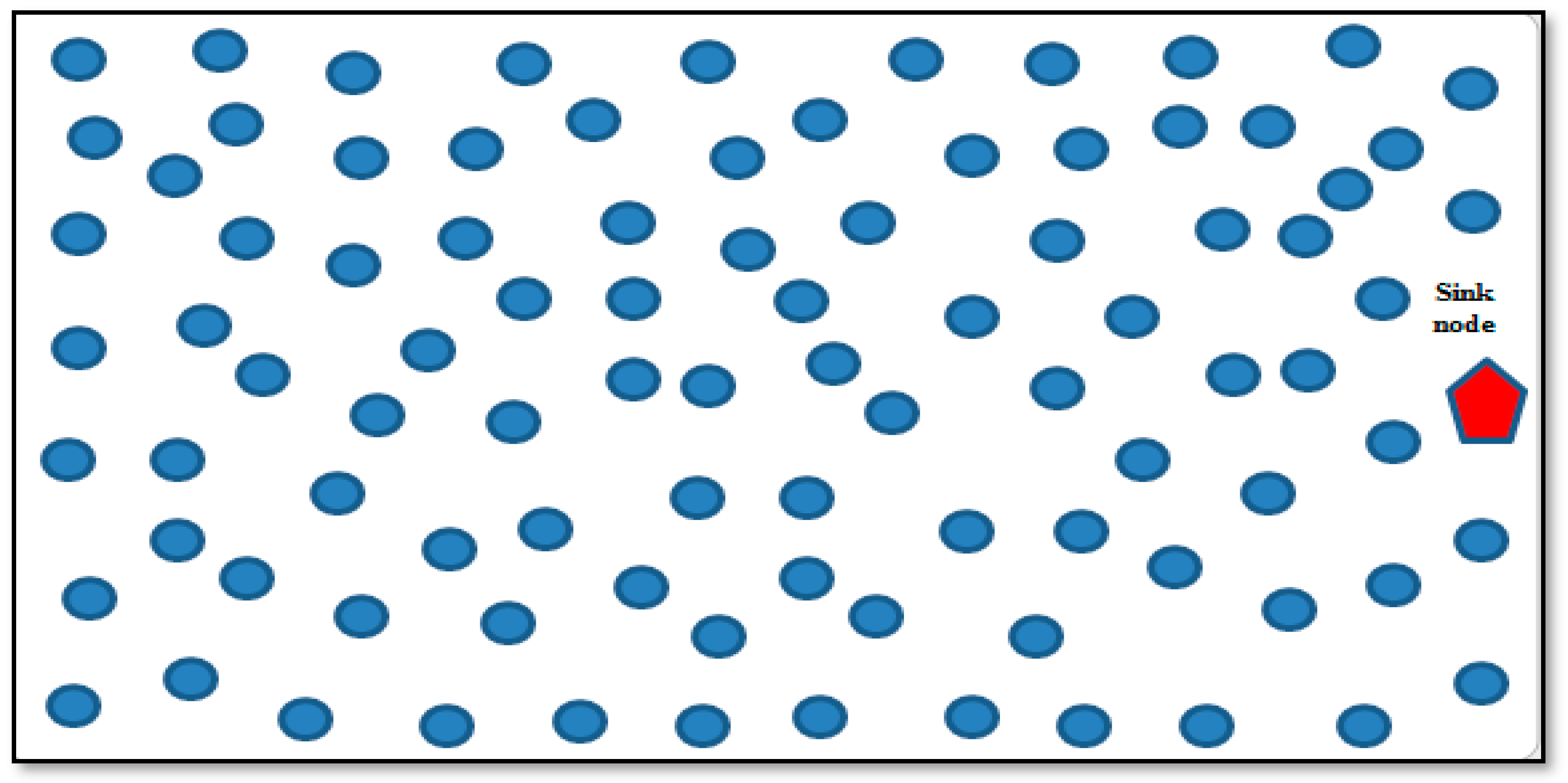
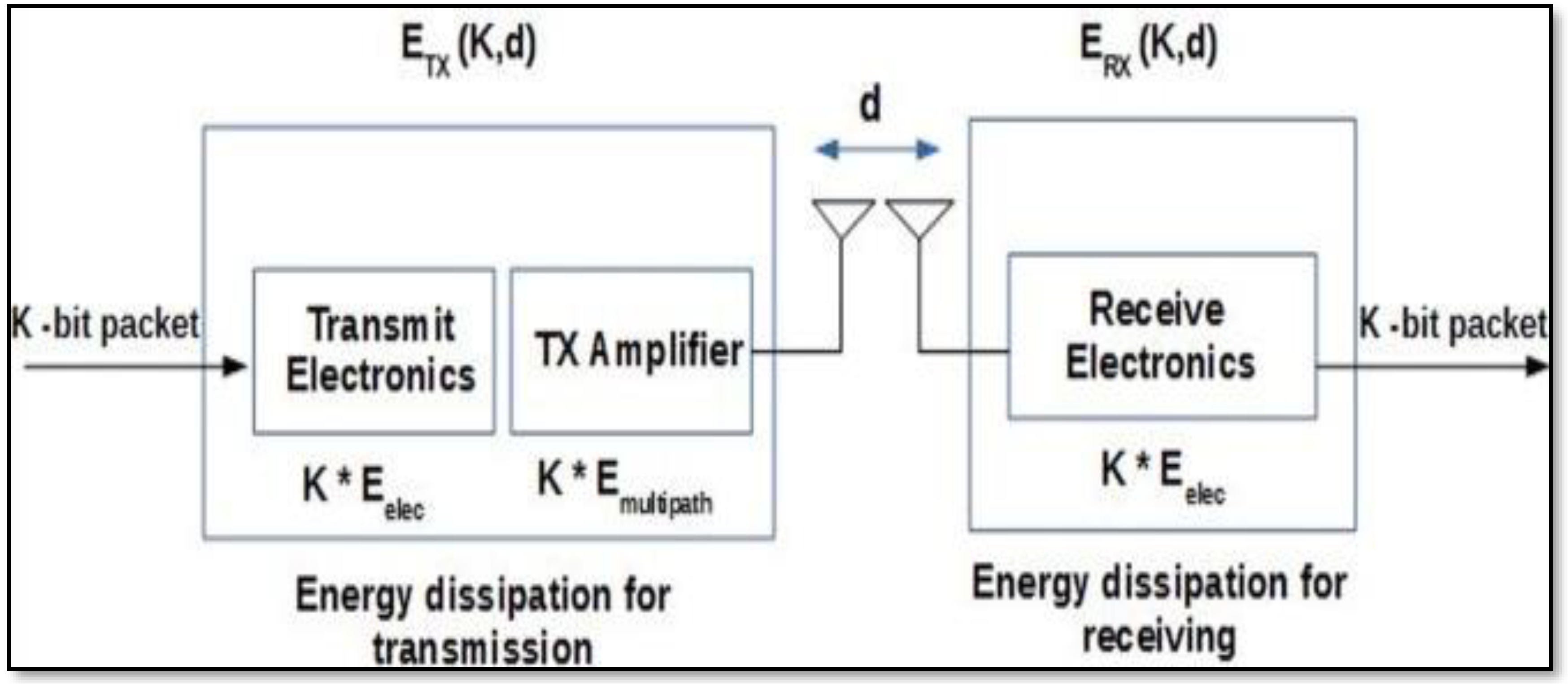
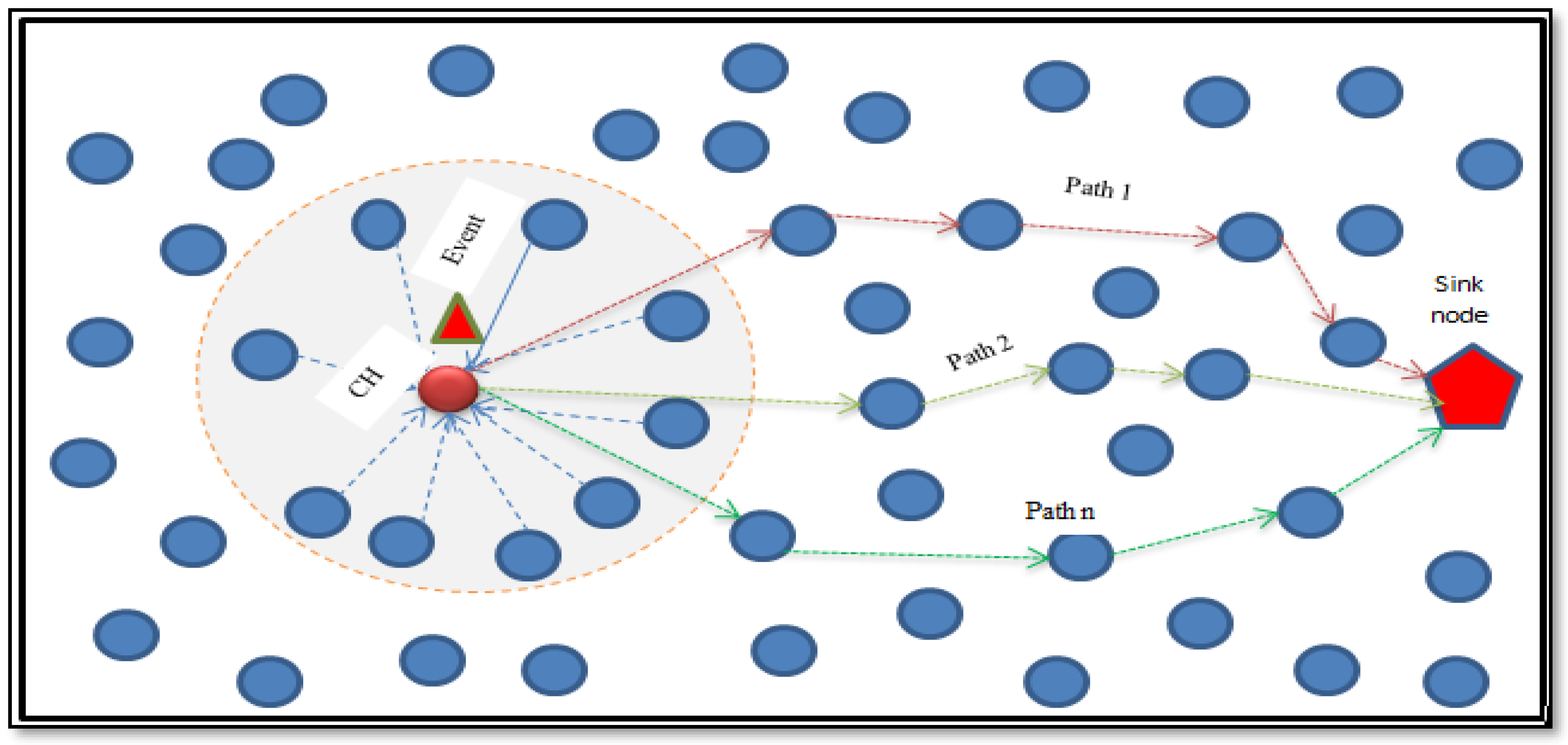

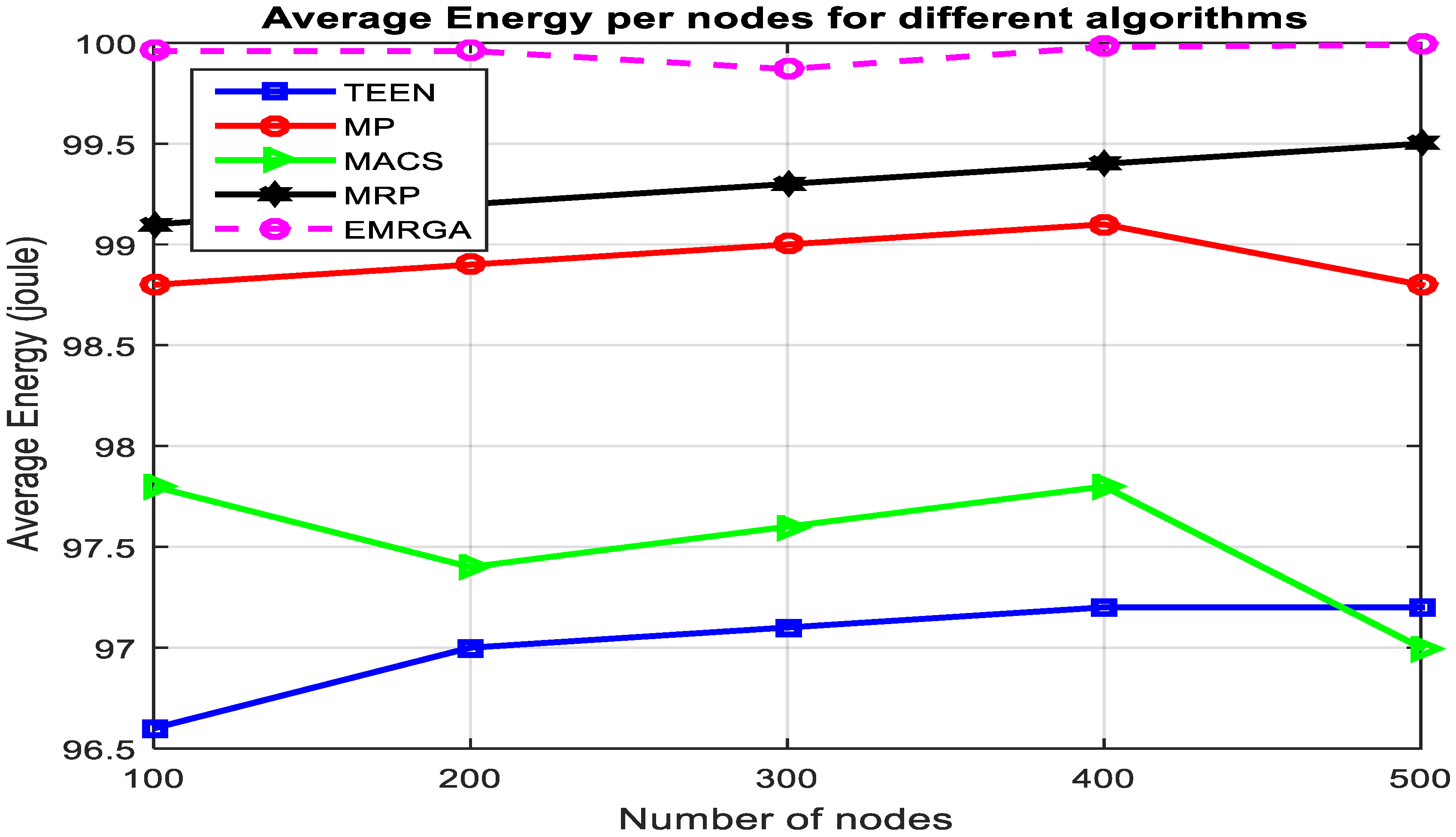
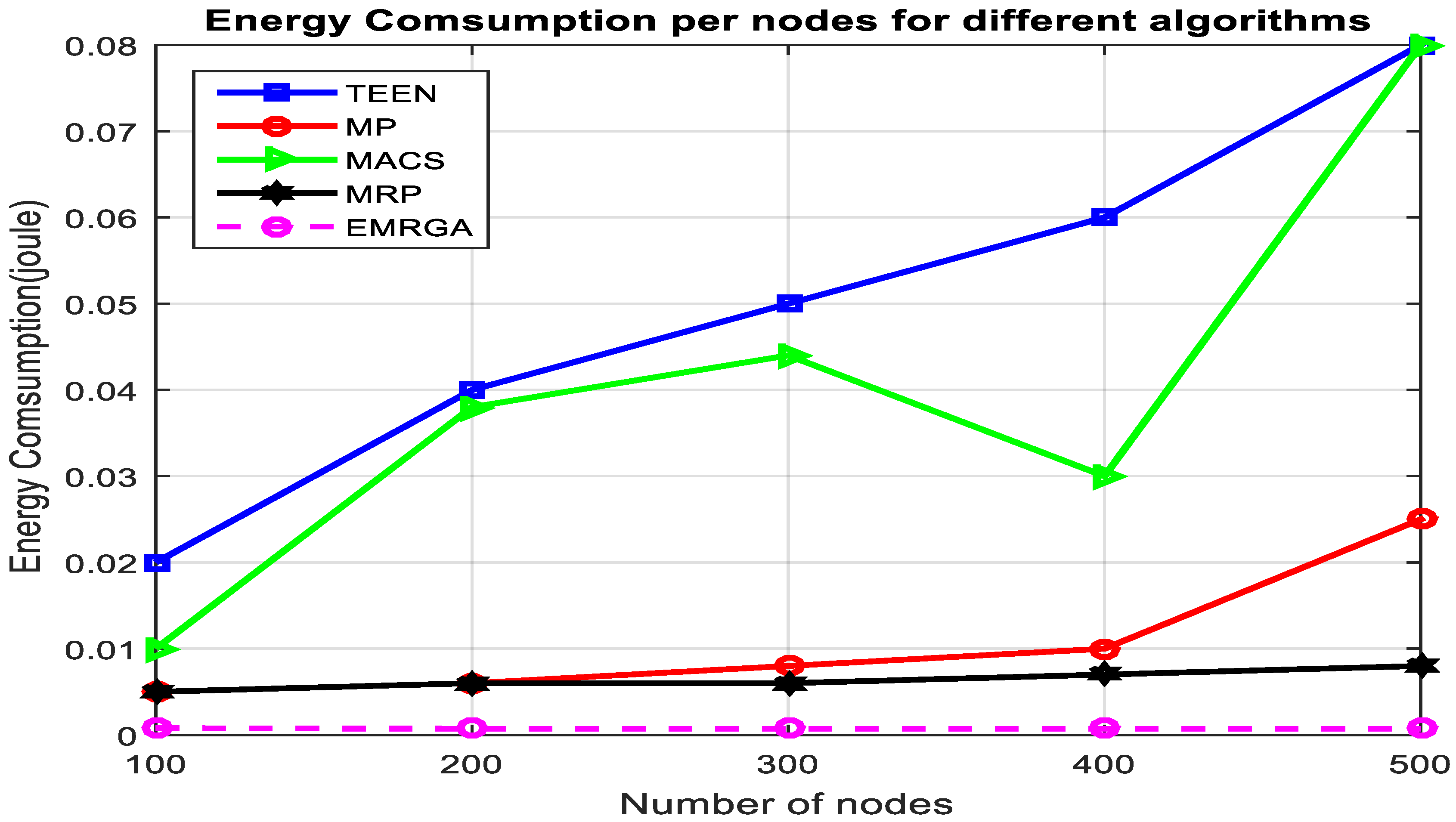
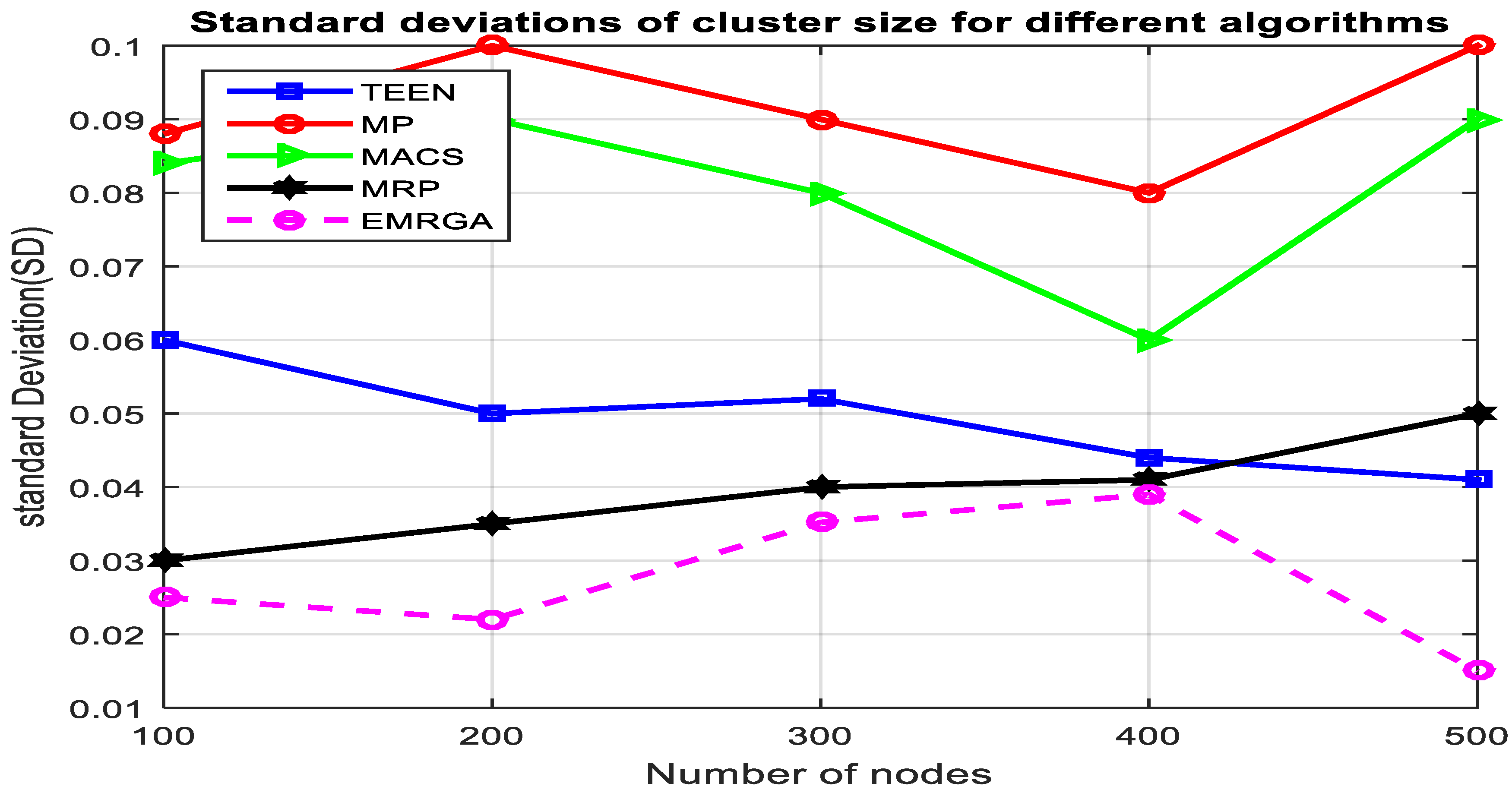
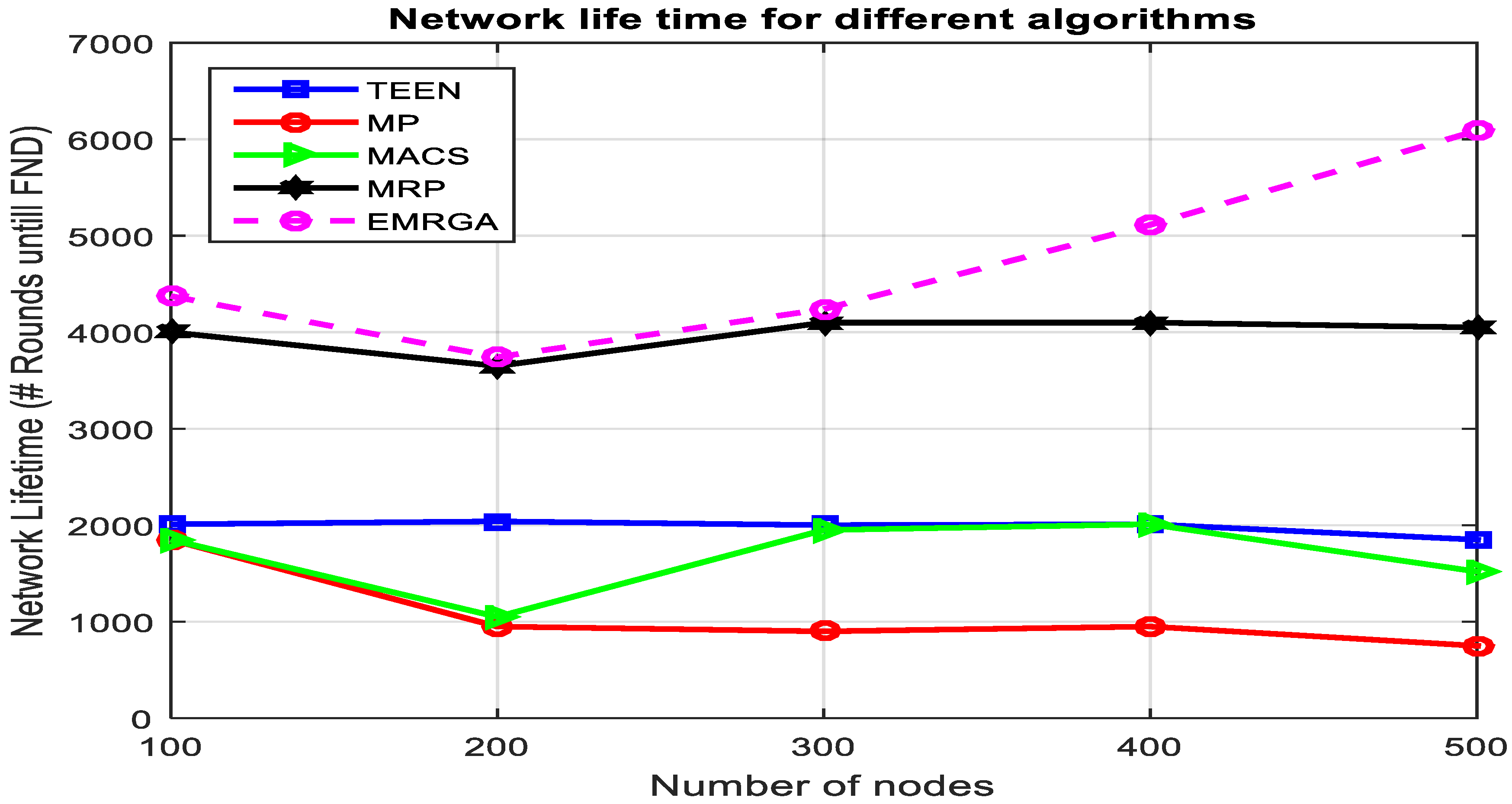




| Symbol | Explanation |
|---|---|
| A sensor node in WMSN | |
| The bidirectional wireless link between in WMSN | |
| Energy consumed during data transmission between in WMSN | |
| The distance between the node | |
| Set of sensor nodes in the event area | |
| N | The total number of sensor nodes in the sensing field |
| M | The total number of sensor nodes in the event area |
| The set of neighboring nodes to node | |
| The thresholdvaluetoselect apply transmission model | |
| Transmission ability in free space model | |
| Transmission ability in multipath fading model | |
| Size of data to be transmitted or received by a node | |
| Energy consumed to send k bits data to a node at a distance | |
| Energy consumed to receive k bits from another node | |
| The distance which the data traveled | |
| Energy consumed for processing data | |
| Electronic energy | |
| The overall cost incurred by a node | |
| Center of the event area | |
| Distance between a node and the center of the event area | |
| Distance between a node and the base station | |
| Residual energy of a particular node | |
| Energy consumption along a particular routing path between the CH and BS | |
| Minimum energy consumption in path p | |
| H | Number of hops in a particular routing path between CH and BS |
| Network lifetime |
| Parameters | Value |
|---|---|
| Sink | 1 |
| Sink position | (0,200) |
| Sensor nodes | 100 |
| Sensing area | 200 m × 200 m |
| Event radius | 20 m |
| Transmission range | 200 m |
| Packet size | 512 bytes |
| Message size | 10 bytes |
| Sensor initial energy (normal nodes) | 2 J (1 J for heterogeneous case) |
| Advanced sensor node initial energy | 2 J |
| , | 5 nJ |
| 10 pJ | |
| 0.0013 pJ | |
| Population size | 100 |
| Crossover probability | 20% |
| Mutation probability | 10% |
© 2019 by the authors. Licensee MDPI, Basel, Switzerland. This article is an open access article distributed under the terms and conditions of the Creative Commons Attribution (CC BY) license (http://creativecommons.org/licenses/by/4.0/).
Share and Cite
Genta, A.; Lobiyal, D.K.; Abawajy, J.H. Energy Efficient Multipath Routing Algorithm for Wireless Multimedia Sensor Network. Sensors 2019, 19, 3642. https://doi.org/10.3390/s19173642
Genta A, Lobiyal DK, Abawajy JH. Energy Efficient Multipath Routing Algorithm for Wireless Multimedia Sensor Network. Sensors. 2019; 19(17):3642. https://doi.org/10.3390/s19173642
Chicago/Turabian StyleGenta, Addisalem, D. K. Lobiyal, and Jemal H. Abawajy. 2019. "Energy Efficient Multipath Routing Algorithm for Wireless Multimedia Sensor Network" Sensors 19, no. 17: 3642. https://doi.org/10.3390/s19173642
APA StyleGenta, A., Lobiyal, D. K., & Abawajy, J. H. (2019). Energy Efficient Multipath Routing Algorithm for Wireless Multimedia Sensor Network. Sensors, 19(17), 3642. https://doi.org/10.3390/s19173642






